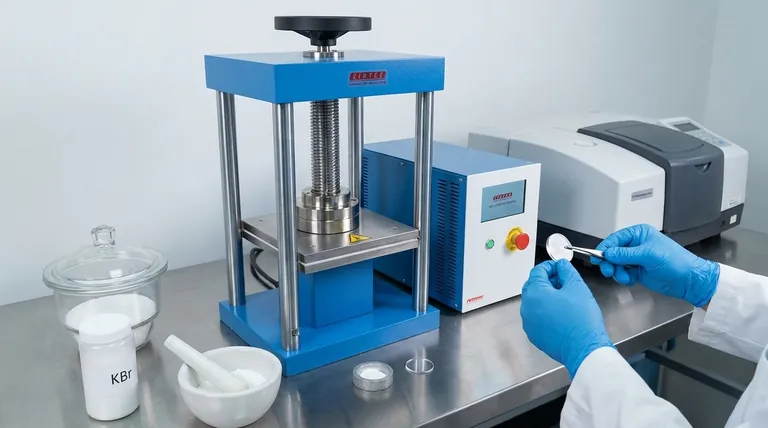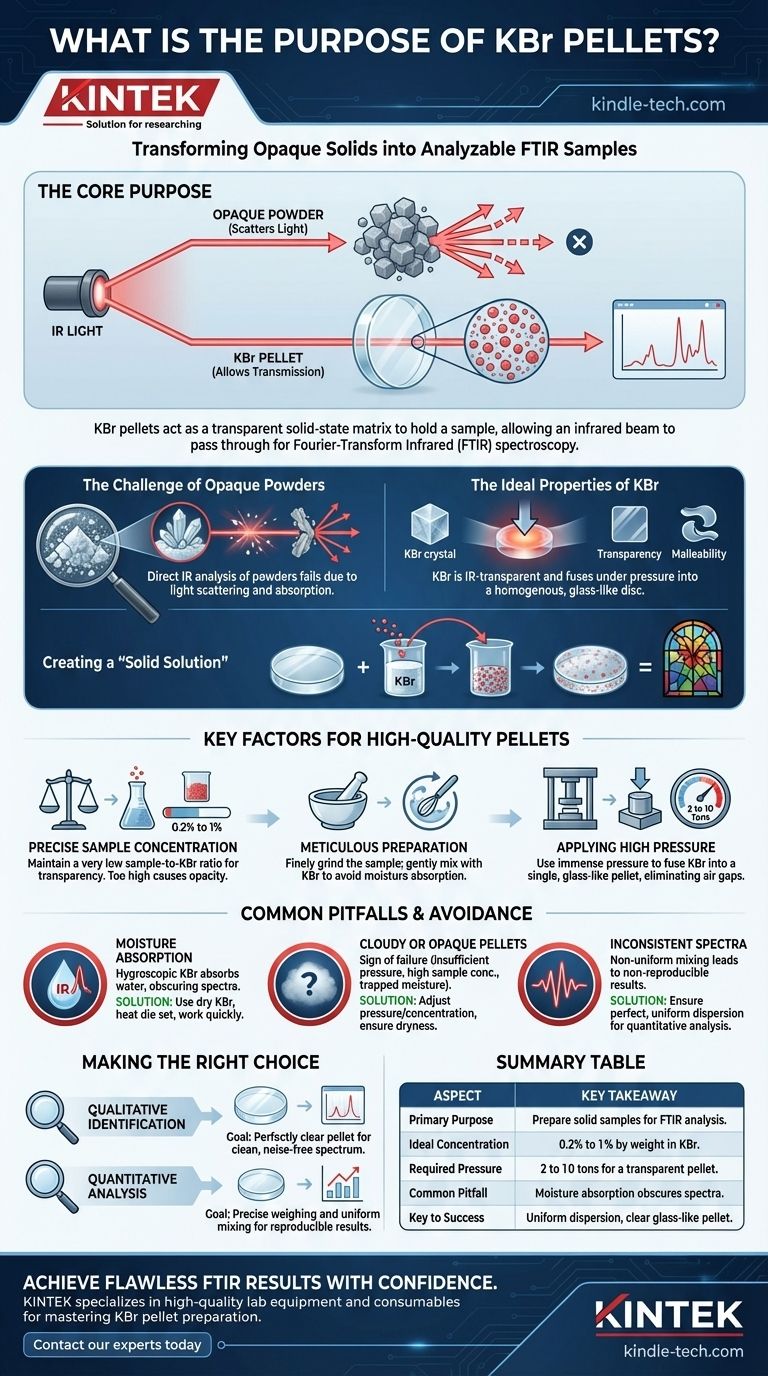Основное назначение таблетки KBr — подготовка твердого образца для анализа с использованием Фурье-спектроскопии в инфракрасной области (ИК-Фурье). Бромид калия (KBr) действует как твердотельная матрица, которая удерживает образец, позволяя инфракрасному лучу проходить через него для измерения.
Анализ твердых образцов с помощью инфракрасного света часто невозможен, потому что непрозрачные порошки рассеивают или блокируют луч. Метод таблеток KBr решает эту проблему, диспергируя порошок образца в инфракрасно-прозрачной соли (KBr), которая затем прессуется в тонкий, стеклоподобный диск, эффективно анализируемый ИК-лучом.

Почему KBr является стандартом для анализа твердых образцов
Понимание метода таблеток KBr начинается с фундаментальной проблемы анализа твердых веществ с помощью света.
Проблема непрозрачных порошков
Большинство твердых органических и неорганических соединений в чистом виде представляют собой кристаллические порошки.
Попытка пропустить ИК-луч непосредственно через порошок приводит к рассеянию света во всех направлениях или полному поглощению, что дает шумный и непригодный для использования спектр.
Идеальные свойства KBr
Бромид калия выбран в качестве материала, потому что он прозрачен для инфракрасного излучения в наиболее распространенном аналитическом диапазоне.
Это также относительно мягкая соль, которая под давлением течет и сплавляется в однородный, прозрачный диск, очень похожий на стекло.
Создание "твердого раствора"
Цель состоит в том, чтобы создать равномерную микроскопическую дисперсию образца в матрице KBr.
Представьте себе это как крошечные фрагменты цветного стекла (ваш образец), идеально взвешенные в прозрачном оконном стекле (KBr). Прозрачное стекло позволяет видеть цвет и свойства фрагментов без помех.
Ключевые факторы для высококачественной таблетки
Качество конечного спектра полностью зависит от качества таблетки KBr. Несколько факторов имеют решающее значение для успеха.
Точная концентрация образца
Концентрация образца в KBr должна быть очень низкой, обычно в диапазоне от 0,2% до 1%.
Слишком высокая концентрация приведет к тому, что таблетка станет непрозрачной, полностью поглощая ИК-луч или вызывая чрезмерное рассеяние. Это приводит к сглаженным пикам и бесполезному спектру.
Тщательная подготовка
Сам образец должен быть измельчен в мелкий порошок, чтобы обеспечить его равномерное диспергирование.
Однако KBr не следует интенсивно измельчать, так как это увеличивает его площадь поверхности и способствует поглощению влаги из воздуха. Образец и KBr осторожно смешиваются вместе.
Применение высокого давления
Для приложения огромного давления, обычно от 2 до 10 тонн, к смеси KBr/образца используются пресс-форма и гидравлический пресс.
Это давление сплавляет отдельные кристаллы KBr в единую, прозрачную, стеклоподобную таблетку, устраняя воздушные зазоры, которые в противном случае рассеивали бы ИК-луч.
Распространенные ошибки и способы их избежать
Наиболее распространенные проблемы с таблетками KBr возникают из-за загрязнения и неправильной техники. Освоение этого метода означает понимание того, что может пойти не так.
Проблема влаги
KBr гигроскопичен, то есть легко поглощает воду из атмосферы. Вода имеет очень сильный и широкий сигнал поглощения в ИК-спектре, который может маскировать важные пики вашего образца.
Чтобы избежать этого, всегда используйте сухой KBr, нагревайте пресс-форму перед использованием, чтобы удалить любую влагу, и готовьте таблетку как можно быстрее.
Мутные или непрозрачные таблетки
Таблетка, которая выглядит мутной или белой, является признаком неудачи. Обычно это вызвано тремя причинами:
- Недостаточное давление, которое не сплавляет кристаллы KBr.
- Чрезмерная концентрация образца, делающая таблетку по своей природе непрозрачной.
- Захваченная влага или пузырьки воздуха, которые рассеивают свет.
Несогласованные спектры
Если образец не равномерно смешан с порошком KBr, некоторые части таблетки будут иметь более высокую концентрацию, чем другие. Это приводит к невоспроизводимым спектрам и делает количественный анализ невозможным.
Правильный выбор для вашей цели
Получение надежного спектра требует адаптации вашей техники к вашей аналитической цели.
- Если ваша основная цель — качественная идентификация: Ваша цель — идеально прозрачная таблетка для получения чистого, бесшумного спектра с резкими, четко определенными пиками.
- Если ваша основная цель — количественный анализ: Вы должны уделять первостепенное внимание точному взвешиванию образца и KBr и обеспечивать идеально равномерное смешивание для достижения воспроизводимых результатов.
- Если вы устраняете неполадки плохого спектра: Сначала проверьте наличие широких, характерных пиков загрязнения водой, затем визуально осмотрите таблетку на предмет мутности, указывающей на рассеяние света.
Освоение метода таблеток KBr — это фундаментальный навык, который превращает непрозрачные твердые вещества в анализируемые образцы, открывая четкие и надежные спектроскопические данные.
Сводная таблица:
| Аспект | Ключевой вывод |
|---|---|
| Основное назначение | Подготовка твердых образцов для ИК-Фурье спектроскопического анализа. |
| Идеальная концентрация образца | От 0,2% до 1% по весу в KBr. |
| Требуемое давление | От 2 до 10 тонн для прозрачной таблетки. |
| Распространенная ошибка | Поглощение влаги, приводящее к замаскированным спектрам. |
| Ключ к успеху | Равномерная дисперсия и идеально прозрачная, стеклоподобная таблетка. |
Достигайте безупречных результатов ИК-Фурье с уверенностью. Метод таблеток KBr является краеугольным камнем надежного анализа твердых образцов. KINTEK специализируется на предоставлении высококачественного лабораторного оборудования и расходных материалов — включая точные гидравлические прессы, прочные пресс-формы для таблеток и чистый, сухой KBr — которые необходимы вашей лаборатории для освоения этой техники.
Устраните переменные непоследовательной подготовки и получите четкие, воспроизводимые данные, которые вам нужны. Свяжитесь с нашими экспертами сегодня, чтобы найти идеальное решение для вашего рабочего процесса спектроскопии.
Визуальное руководство

Связанные товары
- Лабораторный гидравлический пресс с раздельным электрическим прессом для таблеток
- пресс таблеток KBR 2т
- Автоматическая лабораторная гидравлическая таблеточная машина для лабораторного использования
- Лабораторный пресс для гидравлических таблеток для лабораторного использования
- Лабораторный гидравлический пресс для таблеточных батарей
Люди также спрашивают
- Какое усилие может развивать гидравлический пресс? Понимание его огромной мощности и конструктивных ограничений.
- Каково применение бромида калия в ИК-спектроскопии? Получите четкий анализ твердых образцов с помощью таблеток из KBr
- Почему в ИК-Фурье используется пластина KBr? Достижение четкого, точного анализа твердых образцов
- Какое давление может создавать гидравлический пресс? От 1 тонны до 75 000+ тонн силы
- Почему в ИК-Фурье спектроскопии используется KBr? Ключ к четкому и точному анализу твердых образцов



















